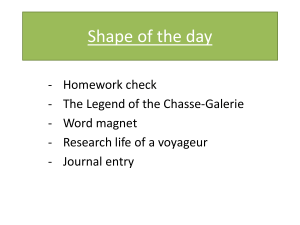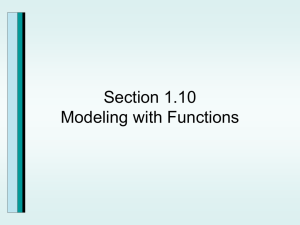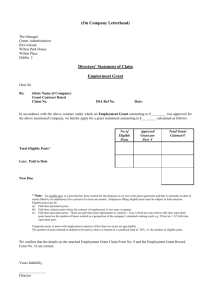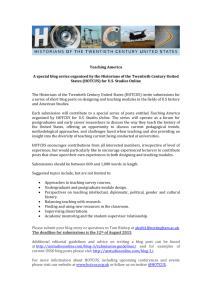FINISH – LINE Installation Instructions Important Instructions on the
advertisement
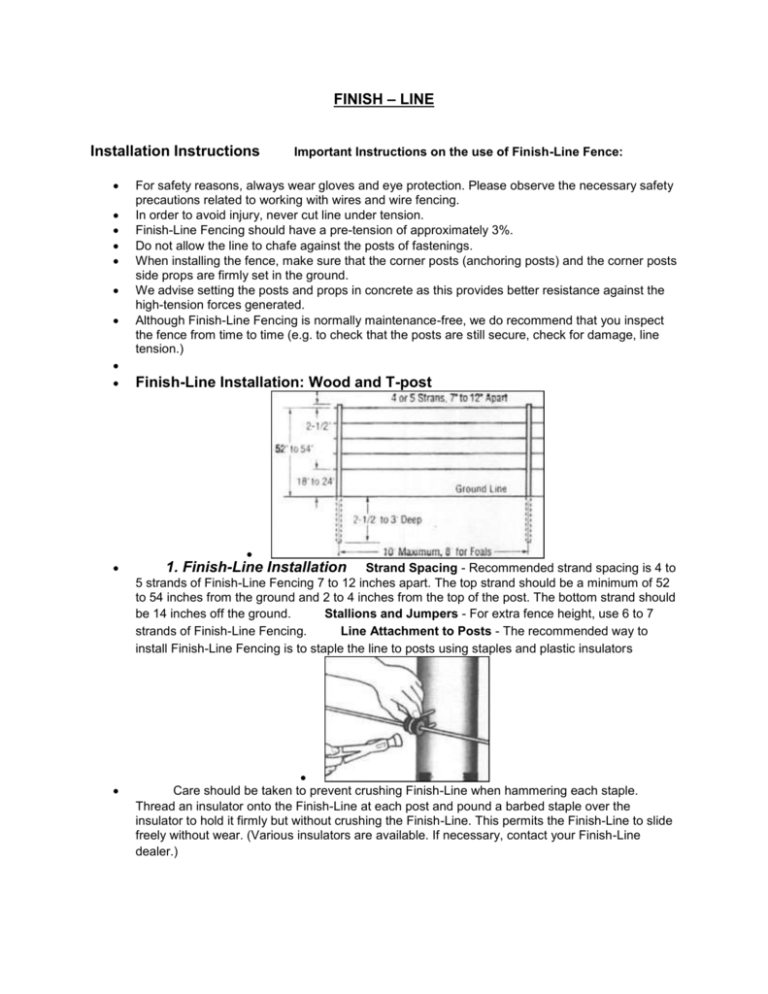
FINISH – LINE Installation Instructions Important Instructions on the use of Finish-Line Fence: For safety reasons, always wear gloves and eye protection. Please observe the necessary safety precautions related to working with wires and wire fencing. In order to avoid injury, never cut line under tension. Finish-Line Fencing should have a pre-tension of approximately 3%. Do not allow the line to chafe against the posts of fastenings. When installing the fence, make sure that the corner posts (anchoring posts) and the corner posts side props are firmly set in the ground. We advise setting the posts and props in concrete as this provides better resistance against the high-tension forces generated. Although Finish-Line Fencing is normally maintenance-free, we do recommend that you inspect the fence from time to time (e.g. to check that the posts are still secure, check for damage, line tension.) Finish-Line Installation: Wood and T-post 1. Finish-Line Installation Strand Spacing - Recommended strand spacing is 4 to 5 strands of Finish-Line Fencing 7 to 12 inches apart. The top strand should be a minimum of 52 to 54 inches from the ground and 2 to 4 inches from the top of the post. The bottom strand should be 14 inches off the ground. Stallions and Jumpers - For extra fence height, use 6 to 7 strands of Finish-Line Fencing. Line Attachment to Posts - The recommended way to install Finish-Line Fencing is to staple the line to posts using staples and plastic insulators Care should be taken to prevent crushing Finish-Line when hammering each staple. Thread an insulator onto the Finish-Line at each post and pound a barbed staple over the insulator to hold it firmly but without crushing the Finish-Line. This permits the Finish-Line to slide freely without wear. (Various insulators are available. If necessary, contact your Finish-Line dealer.) Line Attachment to Corner/End Posts - It is recommended that Finish-Line Fencing go around the outside of round corner posts and be stapled over an 8" protective insulator. On square end and corner posts, it is recommended that each strand of Finish-Line Fencing terminate and be anchored to the post with a one-way vice, in order to protect the fencing from the sharp edge of the post. For anchoring Finish-Line Horse Fencing to end posts, it is recommended that a "one-way vice" be used. The one-way vice eliminates weaknesses caused by knotting. To install the one-way vice, drill end posts with a 5/8 inch wood drill bit, push the strand through, and slip on the one-way vice. The jaw system automatically grips and prevents slipping after the strand is pulled through the vice. Ask your Finish-Line dealer which commercial vice is most appropriate for your fencing application. Other Installation Options - FinishLine Fencing can be installed by drilling through line posts and running the Finish-Line Fencing through holes to the end post where it will be anchored. If through-the-post installation is selected, a wooden template (2" x 2" x 6') with holes pre-drilled at the selected spacing will allow fast hole alignment and allow the horse fence to follow the contours of the land. To drill holes, use a battery-operated or portable generator-operated electric drill with a 5/16" or 3/8" wood drill bit. For large diameter posts, a 5/16" bell hanger installer drill bit permits drilling through the thickest posts. Drills, bits, and portable generators are normally available at hardware stores and equipment rental stores. NOTE: The use of through-the-post installation carries with it the risk of abrasion leading to the possibility of Finish-Line strand failure. We recommend using precaution against abrasion. Abrasion can be reduced by using an electrified wire with Finish-Line Fencing, or by using a plastic tubing insulator to protect the Finish-Line Fencing as it passes through each hole in the post. Leave at least one inch of insulator protruding from both sides of the post. It is preferable to have the insulator fit tightly, or glue it within each hole. To drill holes, use a battery-operated or portable generatoroperated electric drill with a 5/16" or 3/8" wood drill bit. For large diameter posts, a 5/16" bell hanger installer drill bit permits drilling through the thickest posts. Drills, bits, and portable generators are normally available at hardware stores and equipment rental stores. NOTE: The use of through-the-post installation carries with it the risk of abrasion leading to the possibility of Finish-Line strand failure. We recommend using precaution against abrasion. Abrasion can be reduced by using an electrified wire with Finish-Line Fencing, or by using a plastic tubing insulator to protect the Finish-Line Fencing as it passes through each hole in the post. Leave at least one inch of insulator protruding from both sides of the post. It is preferable to have the insulator fit tightly, or glue it within each hole. 2. Stretching for Proper Tension Always pull Finish-Line Fencing strand from both ends, for proper tension. Always start at the bottom strand and work your way up to the top strand. And, always leave enough extra fence (6-10 inches) on both ends to attach a strand stretcher at vice grips. Finish-Line can also be tensioned by hand, eliminating the need for special tools. As each strand of FinishLine Fencing is walked out, the strand should be fastened at the far end. At the other end or stretching end, pull each strand of Finish-Line hand tight. Finish-Line Fencing requires a tension of 3% of total strand length. For example, a 400-foot length with a 3% tension, the total length to be pulled is 12 feet (.03x400). After each strand is pulled hand-tight, mark one-half of the amount to be pulled (6 feet of the 12 foot example) on each end of the strand, and pull the mark to the end post. Do NOT pull down hard on Finish-Line with a tension tool or vice grips. Use just a little tension and pull directly toward you. Leave a small amount of fence protruding through each fastening vice on end posts. These strands can be lightly stapled to the end post. With time, it may be necessary to retighten loose strands caused by post movement. Splicing - It is recommended that strand joiners be used when splicing Finish-Line strands, if splicing between posts is necessary. Strain the strand ends to butt together, slip on the strand joiner, and release. Loss of Tension - With time, the tension in Finish-Line Fencing may loosen due to movement of fence posts. Fencing should be checked occasionally for a resonant "twang" when each strand is plucked. If this "twang" cannot be heard, additional tightening is recommended after locating and correcting loose posts Electrified Wire - Horses which have a tendency to rub fencing continually or "play" with fencing can lead to problems for the fence and the horse. In cases of frequent horse contact with Finish-Line Fencing, an electrified wire is recommended. Finish-Line Fencing cannot carry a electrical charge itself, but a Finish-Line Fence can be electrified in several ways. The inclusion of a single electric strand is recommended as the best way to reduce horse contact with the fence. Several products are available that will complement your Finish-Line Fencing appearance and safety. An electrified fence will reduce the overall number of posts and Finish-Line strands needed. Using Finish-Line Fencing in combination with an electrified wire, posts can be spaced 12 to 16 feet apart, and only 3 to 4 strands of Finish-Line Fencing can be used. Post Installation: Wood Posts 1. Post Installation Start your Finish-Line Safe Horse Fence installation by setting end and corner posts, and line posts. Choice of Posts - Posts should be high quality pressure treated round posts or those of composite materials. End and corner posts should be heavy duty composite posts 4 to 6 inches in diameter or round wood posts 5 to 6 inches in diameter. Line posts should be at least 3 inches in diameter. Al posts should be 7 to 8 feet long. While not recommended as preferred post material, Finish-Line Fencing can be installed on metal posts if the fencing is protected from rubbing against the metal, and the metal post is smooth. Excessive rubbing against metal posts and staples can cause Finish-Line Fencing to eventually break. If metal posts are used, choose a synthetic material to insulate and protect Finish-Line Fencing. Setting End and Corner Posts - Set each end and corner post in a hole 3 feet deep. Fill around the posts first with soil, crushed rock, or pea gravel (6 to 8 inches). Tamp with a bar to compact the material. Next, add redi-mix cement (12 inches), or more crushed rock or pea gravel tamped every 4 to 6 inches. Setting Line Posts - Set each line post 2 1/2 to 3 feet, depending on soil conditions. Spacing for line posts are recommended to be placed from 8 to 12 feet apart. (for foals, 8 feet). 2. Post Bracing Using the same post material as for end and corner posts, construct an angle support brace as follows. Mark the end post 3 1/2 feet from ground level to inducate where the bottom of the support brace will be nailed diagonally to the end post. The support brace should enter the ground approximately 3 1/2 feet from the end post, and be anchored in a cement pad (20" x 20" x 6") or anchored with a redwood stake (4" x 8" x 18") driven into the ground against the brace. (If available, channel iron 6 to 8 inches wide by 18 inches long can be used.) Attach Finish-Line Horse Fencing to braces in the same manner as line post strand attachment. (If through-the-post installation is used, drill holes through the support brace for lower fencing strands to pass through to the end post.) Finish-Line Installation: Vinyl Fencing Spacing We recommend that you space 5 strands of Finish-Line Fencing 7 to 12 inches apart. (Fig.5) The top strand should be a minimum of 48 to 54 inches from the ground and 2 to 4 inches from the top of the post. The bottom strand should be 14 to 20 inches off the ground. (We recommend that you include the use of an Electric Rope as a top line. If you do this, increase the hole diameter from 9/32" to 5/8" or use an offset bracket. This will enable the electric poly rope to run through the post.) This will keep the horses off the fence, which is desirable with any fence system. If predators are a concern, use a strand of Electric Fence line as the bottom line. Stallions and Jumpers For extra fence height, use 6 to 7 strands of Finish-Line Fencing. Fencing can be used to separate stallions and mares. It can also be used to create a walkway between them. An optional 1½" x 5½ " or 2" x 6" top rail or mid rail may be added for a more visible barrier. Installation Finish-Line Equine Fencing can be installed by drilling through line posts and running Finish-Line wire through the holes to the end post where it will be secured. Posts can be ordered pre-drilled. A wood template (2" x 2" x 6") with 9/32" holes pre-drilled will allow for fast hole alignment. For installation on hillsides, drill holes slightly lower on the down hill side of the post. Line Attachment to Line Posts When it comes to vinyl horse fence posts, the best way to install Finish-Line is to drill the required number of holes in the rail post. This allows the Finish-Line to ride smoothly through the center of the post. This improves the aesthetics of the fence and reduces maintenance. This is standard on all 5" vinyl post. Post Installation: Vinyl Fencing 1. Post Installation Start your Finish-Line horse fence installation by setting end and corner posts. End and corner posts should be 5" square vinyl fencing posts with 4"x4" wood post inserts. The wood post inserts are available locally, or an aluminum insert may be special ordered. If using a wood insert, locate in corner where the wire wraps around the post. (Fig.3) All end and corner posts should be a minimum of 8' lengths. We recommend you use heavy wall posts. Line post should be at least 5" square to allow for any future changes. All line posts should be a minimum of 7' lengths. Setting End and Corner Posts Set each end and corner post in a hole 3 feet deep. Fill around the post with soil, crushed rock, or pea gravel (6 to 8 inches). Make sure the material is compacted. Next, add redi-mix cement (12 inches) or more crushed rock or pea gravel packed every 4 to 6 inches. All end and corner post must be crossbraced. (Fig.2) Setting line posts Set each line post a minimum of 2 feet deep, depending on soil and climatic conditions. Augering is the easiest way to make holes for posts. Post Spacing If you simply have a Perimeter Fence System, posts should be spaced at 8' intervals. You will not need as many Finish-Line strands with an electrified fence. 2. Post Bracing Place a mark on the end post 3 ½ feet from the ground level. This will indicate where the bottom of the diagonal support brace will be fastened. It will be fastened to the post using a treated lumber 2"x4" (available locally). Ask your equine fencing dealer to oversleeve the 2" x 4" with vinyl. (Fig.3) The support brace should enter the ground about 3 ½ feet from the end post and must be secured in a cement pad (20" x20" x6"). Usually, holes do not need to be drilled in the corner posts. Posts should be installed so the wire is stretched tight around the outside of the post. (Fig.3) To install the fence through the post, however, drill 9/32" holes through the diagonal support brace so lower fencing strands can pass through to an end post. (Fig.4) The photos below show how to use a knot and washer for an alternative way to terminate. You still need to use a one way anchor vice at the opposite termination point.



